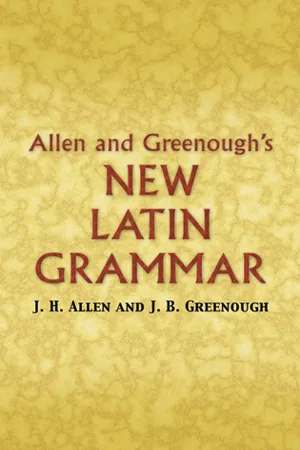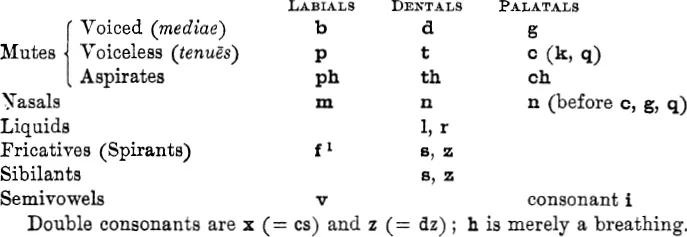
eBook - ePub
Allen and Greenough's New Latin Grammar
- 512 pages
- English
- ePUB (mobile friendly)
- Available on iOS & Android
eBook - ePub
Allen and Greenough's New Latin Grammar
About this book
A venerable resource for more than a century, Allen and Greenough's New Latin Grammar is still regarded by students and teachers as the finest Latin reference grammar available. Concise, comprehensive, and well organized, it is unrivaled in depth and clarity, placing a wealth of advice on usage, vocabulary, diction, composition, and syntax within easy reach of Latin scholars at all levels.
This sourcebook's three-part treatment starts with words and forms, covering parts of speech, declensions, and conjugations. The second part, syntax, explores cases, moods, and tenses. The concluding section offers information on archaic usages, Latin verse, and prose composition, among other subjects. Extensive appendixes feature a glossary of terms and indexes. Students of history, religion, and literature will find lasting value in this modestly priced edition of a classic guide to Latin.
This sourcebook's three-part treatment starts with words and forms, covering parts of speech, declensions, and conjugations. The second part, syntax, explores cases, moods, and tenses. The concluding section offers information on archaic usages, Latin verse, and prose composition, among other subjects. Extensive appendixes feature a glossary of terms and indexes. Students of history, religion, and literature will find lasting value in this modestly priced edition of a classic guide to Latin.
Frequently asked questions
Yes, you can cancel anytime from the Subscription tab in your account settings on the Perlego website. Your subscription will stay active until the end of your current billing period. Learn how to cancel your subscription.
No, books cannot be downloaded as external files, such as PDFs, for use outside of Perlego. However, you can download books within the Perlego app for offline reading on mobile or tablet. Learn more here.
Perlego offers two plans: Essential and Complete
- Essential is ideal for learners and professionals who enjoy exploring a wide range of subjects. Access the Essential Library with 800,000+ trusted titles and best-sellers across business, personal growth, and the humanities. Includes unlimited reading time and Standard Read Aloud voice.
- Complete: Perfect for advanced learners and researchers needing full, unrestricted access. Unlock 1.4M+ books across hundreds of subjects, including academic and specialized titles. The Complete Plan also includes advanced features like Premium Read Aloud and Research Assistant.
We are an online textbook subscription service, where you can get access to an entire online library for less than the price of a single book per month. With over 1 million books across 1000+ topics, we’ve got you covered! Learn more here.
Look out for the read-aloud symbol on your next book to see if you can listen to it. The read-aloud tool reads text aloud for you, highlighting the text as it is being read. You can pause it, speed it up and slow it down. Learn more here.
Yes! You can use the Perlego app on both iOS or Android devices to read anytime, anywhere — even offline. Perfect for commutes or when you’re on the go.
Please note we cannot support devices running on iOS 13 and Android 7 or earlier. Learn more about using the app.
Please note we cannot support devices running on iOS 13 and Android 7 or earlier. Learn more about using the app.
Yes, you can access Allen and Greenough's New Latin Grammar by James B Greenough,J. H. Allen, G. L. Kittredge,A. A. Howard,Benj. L. D'Ooge, G. L. Kittredge in PDF and/or ePUB format, as well as other popular books in Languages & Linguistics & Ancient Languages. We have over one million books available in our catalogue for you to explore.
Information
LATIN GRAMMAR
Latin Grammar is usually treated under three heads: 1. Words and Forms; 2. Syntax; 3. Prosody. Syntax treats of the function of words when joined together as parts of the sentence; Prosody of their arrangement in metrical composition.
PART FIRST—WORDS AND FORMS
THE ALPHABET
1. The Latin Alphabet is the same as the English (which is in fact borrowed from it) except that it does not contain J, U, and W.
NOTE 1.—The Latin alphabet was borrowed in very early times from a Greek alphabet (though not from that most familiar to us) and did not at first contain the letters G and Y. It consisted of capital letters only, and the small letters with which we are familiar did not come into general use until the close of the eighth century of our era.
NOTE 2.—The Latin names of the consonants were as follows:—B, be (pronounced bay); C, ce (pronounced hay); D, de (day); F, ef; G, ge (gay); H, ha; K, ka; L, el; M, em; N, en; P, pe (pay); Q, qu (koo); R, er; S, es; T, te (tay); X, ix; Z, zeta (the Greek name, pronounced dzayta). The sound of each vowel was used as its name.
a. The character C originally meant G, a value always retained in the abbreviations C. (for Gāius) and Cn. (for Gnaeus).
NOTE.—In early Latin C came also to be used for K, and K disappeared except before a in a few words, as Kal. (Kalendae), Karthāgō. Thus there was no distinction in writing between the sounds of g and k. Later this defect was remedied by forming (from C) the new character G. This took the alphabetic place formerly occupied by Z, which had gone out of use. In Cicero’s time (see N. D. ii. 93), Y (originally a form of V) and Z were introduced from the ordinary Greek alphabet to represent sounds in words derived from the Greek, and they were put at the end of the Latin alphabet.
b. I and V were used both as vowels and as consonants (see § 5).
NOTE.—v originally denoted the vowel sound u (oo), and F stood for the sound of our consonant w. When F acquired the value of our f, v came to be used for the sound of w as well as for the vowel u.
In this book i is used for both vowel and consonant i, u for vowel u, and v for consonant u:—iūs, vir, iuvenis.
Classification of Sounds
2. The simple Vowels are a, e, i, o, u, y.
The Diphthongs are ae, au, ei, eu, oe, ui, and, in early Latin, ai, oi, ou. In the diphthongs both vowel sounds are heard, one following the other in the same syllable.
3. Consonants are either voiced (sonant) or voiceless (surd). Voiced consonants are pronounced with the same vocal murmur that is heard in vowels; voiceless consonants lack this murmur.
1. The voiced consonants are b, d, g, l, r, m, n, z, consonant i, v.
2. The voiceless consonants are p, t, c (k, q), f, h, s, x.
4. Consonants are further classified as in the following table:

1. Mutes are pronounced by blocking entirely, for an instant, the passage of the breath through the mouth, and then allowing it to escape with an explosion (distinctly heard before a following vowel). Between the explosion and the vowel there may be a slight puff of breath (h), as in the Aspirates (ph, th, ch).2
2. Labials are pronounced with the lips, or lips and teeth.
3. Dentals (sometimes called Linguals) are pronounced with the tip of the tongue touching or approaching the upper front teeth.
4. Palatals are pronounced with a part of the upper surface of the tongue touching or approaching the palate.3
5. Fricatives (or Spirants) are consonants in which the breath passes continuously through the mouth with audible friction.
6. Nas...
Table of contents
- Cover
- Title Page
- Copyright Page
- Publisher Note
- Preface
- Contents
- Part I — Words And Forms
- Part II —Syntax
- Prosody
- Glossary Of Terms
- Index Of Verbs
- Index Of Words And Subjects
- Latin Authors And Their Works